Seven Best Annuals for Veggie Gardens
Gardens can tend to look rather bland and can be more practical than beautiful. The addition of beautiful flowering plants can bring back the beauty that every garden deserves. Using the right annual plants strategically will not only bring the garden back to life visually but can help your veggies stay healthy and pest free.
This article references the first and the last frost dates. To find these dates for your area, click this link: Https://garden.org/apps/calendar
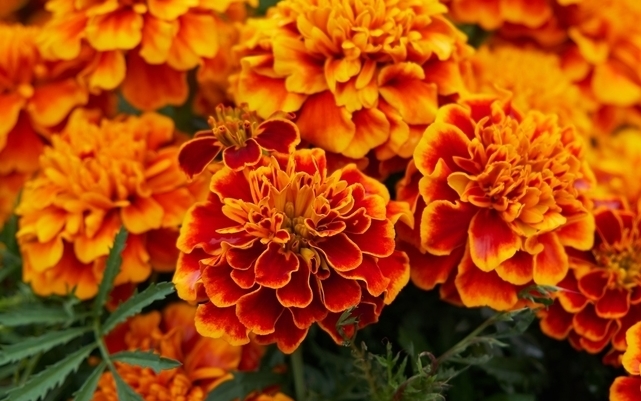
1. Marigolds
Height 6”-18”
Days to Bloom from Seed: 50 – 80 days
Marigolds are a warm-season annual that's as easy to grow as they are cheerful. They thrive in warm weather and full sun and provide a splash of yellows, golds, oranges, and reds into summer and autumn gardens.
Benefits of Marigolds in the Vegetable Garden
- Both French and African marigolds produce a substance called alpha-terthienyl which suppresses nematodes and microscopic worms that attach to the roots of some plants.
- They draw in bees. It has been reported that bees prefer single bloom varieties.
- They protect your tomato plants from nematodes, tomato hornworms, slugs, and other pests. The French Marigolds are the best choice for tomato protection.
- They are great companions for lots of veggies including bush beans, broccoli, squash, eggplant, kale, and cabbage. They will deter pests like bean beetles, hornworms and leafhoppers. The French kind of Marigold is also best for this.
How to Grow Marigolds From Seed
Direct Sow
Sow Marigold seeds directly into the garden or in a container once the soil has warmed. Marigolds will bloom from seed in roughly eight weeks.
Planting Out
Plant Marigolds 7” apart after all threat of frost has passed. If you've grown them from seed, the plants will need to be hardened off first.
To read our article on how to harden off your plants, click here.
Caring for Marigolds
Sun: They love sun and heat.
Soil: Moderately fertile and well-drained.
Water: Allow the water to dry out between waterings then soak through.
Fertilizer: A slow-acting fertilizer at planting time is sometimes all they will need. Do not fertilize during active growth.
Care:
Deadheading the spent blooms will greatly increase the number of blooms as well as lengthen the blooming time.
Mulch to prevent weeds, keep roots cool and conserve moisture.
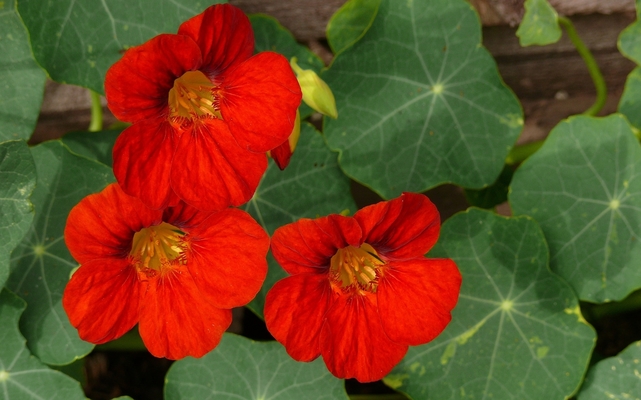
 |
| Click to View |
2. Nasturtium
Height 6” - 12”
Days to Bloom from Seed: 35 to 50 days
Nasturtiums are cool-season annuals that is low-growing and just plain beautiful. They come in a variety of types including compact, dwarf, climbing, and trailing.

Click to View

Benefits of Nasturtium in the vegetable garden

- Nasturtium attracts hoverflies which destroy aphids.
- They improve the flavor of cucumbers and deter whiteflies and cucumber beetles.
- They deter squash beetles and borers when planted next to melons and squash.
- They keep away Japanese beetles, aphids, cabbage loopers, and cabbage worms when planted near any vegetable in the cabbage family.
- They repel the coddling moth when planted under apple trees.
- They help in the herb garden by attracting pollinators such as hummingbirds and bees.
- They keep away Colorado Potato bugs.
How to Grow Nasturtium From Seed
Direct Sow
Nasturtium seeds are fairly large and can be planted directly into the garden. Sow them an inch deep after the danger of frost has passed.
Planting Out
Plant Nasturtium 10” apart as soon as nighttime temperatures are in the 50s. If the nighttime temps dip down after that, cover them for the night to prevent damage.
Care for your Nasturtium
Sun: Give Nasturtium some protection from strong sun and strong winds.
Soil: They can thrive even in poor soil.
Water: They prefer drier soil, but don't allow them to totally dry out.
Fertilizer: Feeding them with liquid fertilizer will ensure plenty of blooms throughout the season.
Care: Pinch out runners to encourage more flowers or to grow in a more compact shape.
Mulch to prevent weeds, keep roots cool and conserve moisture.
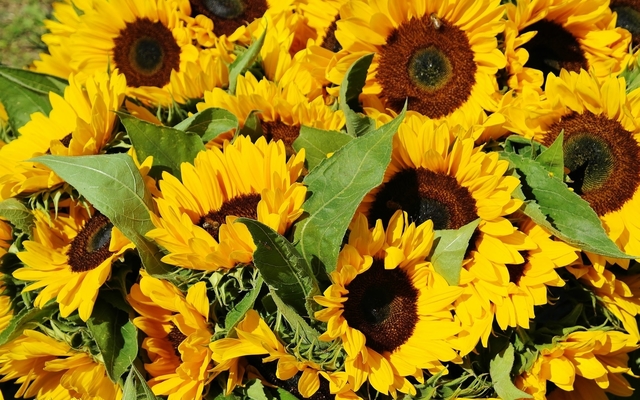
3. Sunflowers
Height: 4' to 12'
Days to bloom from seed: 80 – 120 days
Sunflowers are warm-season annuals that come in an endless array of sizes.
Benefits of Sunflowers in the vegetable garden
- Sunflowers draw local birds to your garden.
- They lure in beneficial insects which then improve the pollination of fruits and veggies and plants.
- The tall varieties of Sunflowers can give some much-needed
- respite to those shade-loving veggies.
- Sunflowers can be used as a trellis for climbing plants that have lots of nectar to attract even more pollinators.
How to Grow Sunflowers From Seed
Direct Sow
Sow the large seeds directly into the ground once all threat of frost has passed. The soil temperature needs to be 70 – 75 degrees for the Sunflower seeds to germinate.
Indoor Sow
For an earlier start, sow Sunflower seeds indoors three weeks before the expected last frost date.
Planting Out
Plant out Sunflower plants or seedlings after the threat of frost has passed.
Care for your Sunflowers
Sun: Full sun.
Soil: Compost rich soil.
Water: Frequent water, but never soggy. They are drought-tolerant.
Fertilizer: The larger the sunflower head, the more nutrition the plant will need. Use a well-balanced water-soluble fertilizer a few times during the blooming season. Be aware that too much nitrogen may delay flowering.
Care:
 Stake tall cultivars.
Stake tall cultivars.
Mulch to prevent weeds, keep roots cool and conserve moisture.
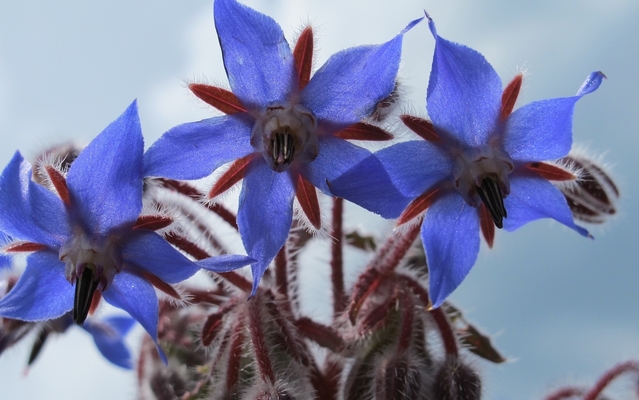
4. Borage
Height: 18” - 36”
Days to bloom from seed: 50 – 60 days
Borage is a warm-season annual herb that is often overlooked as a veggie garden helper. It is easy to grow as well as virtually problem-free. It has beautiful flowers that start out pink and turn a vivid blue.
Benefits of Borage in the vegetable garden
- Borage attracts pollinating bees. It's considered a bee magnet!
- It deters cabbage moths.
- It's a great companion plant for tomatoes by deterring tomato hornworms.
- Borage acts as a slug and snail trap with its hairy leaves.
- It self seeds in colder climates so plant once and give it some room to expand if desired.
How to Grow Borage From Seed
Direct Sow
Direct sow Borage seeds after all risk of frost have passed. Borage is very sensitive to transplanting, so direct sowing is recommended rather than starting them indoors.
Planting Out
Plant Borage plants 12” apart after the damage of frost has passed. Choose an area that is sheltered from high winds.
Care for Borage
Sun: Grows best in full sun to part shade.
Soil: Tolerant of any type of soil.
Water: Moderate water.
Fertilizer: None, unless the soil is very poor.
Care:
Pinch back stems to encourage branching or to keep them shorter. Mulch to prevent weeds, keep roots cool, and conserve moisture.
5. Calendula (Potted Marigold)
Height: 18” to 24”
Days to bloom from seed: 45-60 days.
Calendula is an annual herb that grows quickly and is tolerant of cooler temperatures. It blooms well into the fall season.
Benefits of Calendula in the vegetable garden
- Calendula attracts beneficial insects such as ladybugs, hoverflies and lacewings.
- It attracts bees and butterflies.
- It is considered a “trap crop.” It traps pests like aphids, whiteflies, and thrips by exuding a sap that they find more appealing than nearby crops.
- Growing it near cabbage results in fewer problems with aphids, cabbage worms, and diamondback moths.
How to Grow Calendula From Seed
Direct Sow
Direct sow from early Spring through the Summer.
Sow Indoors
Sow Calendula seeds 4-6 weeks before your expected last frost date.
Planting Out
Plant out Calendula plants 9” apart after all threat of frost has passed.
Care for your Calendula
Sun: Full sun to part shade. Flowers last longer when sited in filtered sun or shady areas.
Soil: Sandy, compost, rich soil.
Water: Light watering throughout the garden season.
Fertilizer: Light fertilizer to increase bloom.
Care:
Deadhead to increase bloom.
Mulch to prevent weeds, keep roots cool and conserve moisture.
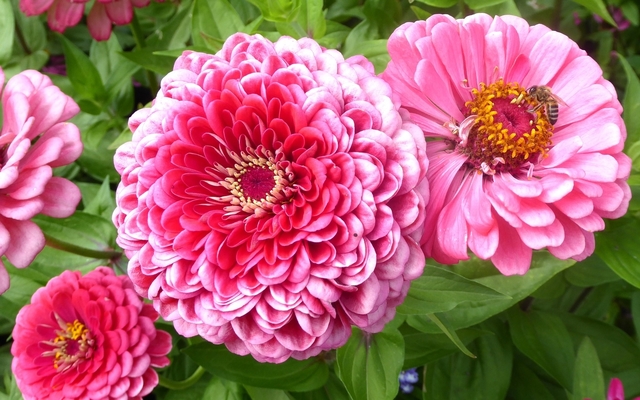
6. Zinnia
Height: 18” - 24”
Days to bloom from seed: 60 – 75 days
With its long-lasting blooms and ability to thrive in virtually any condition, even hot sun as well as damp, cool areas, Zinnia makes an easy choice to plant in your vegetable garden.
Benefits of Zinnia in the vegetable garden
- Zinnia attracts beneficial pollinators.
- It attracts beneficial insects like lacewings, ladybugs, hoverflies, and parasitic wasps.
- It deters cucumber beetles and tomato worms.
- It attracts hummingbirds that eat whiteflies. Whiteflies are known to damage tomatoes, cucumbers, and potatoes.
- The pastel-colored Zinnia serve as a trap crop for Japanese beetles.
How to Grow Zinnia From Seed
Direct Sow
Direct sow when all threat of frost has passed. Zinnias do not like to be transplanted so direct sowing is recommended.
Planting Out
Plant Zinnia plants 6-12” apart after all threat of frost has passed.
Care for your Zinnia plants
Sun: Full sun.
Soil: Zinnia can perform in average soil, but best with organic matter added.
Water: Thrive in dry conditions. Water thoroughly less often.
Fertilizer: An application of slow-release fertilizer at plant out and again mid-season will help Zinnia plants to grow strong and healthy.
Care: For bushier Zinnia plants, pinch off an inch from the tips of the main stems while the plants are still young.
Mulch to prevent weeds, keep roots cool and conserve moisture.
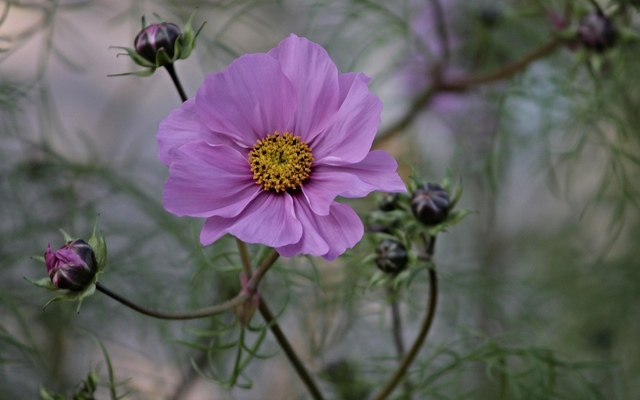
7. Cosmos
Height: 1' to 5'
Days to bloom from seed: 50-60
Cosmos is a heat-loving annual that has bright, colorful daisy-like blooms on long stems with fern-like leaves. Their single or semi-double blooms are great for cutting. It's easy to sow from seed, a low-maintenance annual and will bloom until frost.
Benefits of Cosmos in the vegetable garden
- Cosmos attracts birds and butterflies.
- It attracts aphids drawing them away from other plants.
- The white and orange Cosmos attract bees and green lacewings.
- If planted between rows of corn, Cosmos deters the corn worm.
- Cosmos is particularly useful late in the season to attract pollinators for beans and tomatoes.
How to Grow Cosmos From Seed
Direct Sowing
Direct sow after danger of all frost has passed.
Planting Out
Plant out Cosmos plants after danger of frost is passed.
Care for your Cosmos plants
Sun: Full sun.
Soil: Cosmos can grow in poor soil.
Water: Cosmos likes drier soil. Overwatering can lead to fewer flowers.
Fertilizer: A general-purpose fertilizer a few times during the season will keep Cosmos stay healthy.
Care: Deadhead blooms for branching.
Cosmos reseeds easily and will self-sow if not deadheaded.
Give Cosmos protection from strong winds.
~~~~~~~~~~
Growing annuals and vegetables together can not only add beauty to your vegetable garden, but it's a great organic choice for pest control!
~~~~~~~~~~











.png)






No comments:
Post a Comment
Note: Only a member of this blog may post a comment.